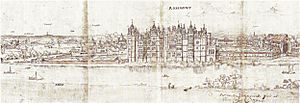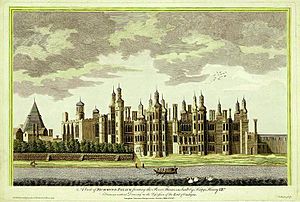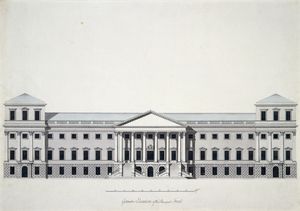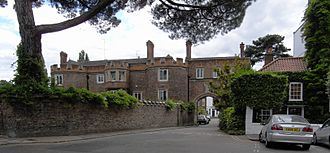Richmond Palace facts for kids
Quick facts for kids Richmond Palace |
|
|---|---|

Richmond Palace, west front, drawn by Antony Wyngaerde, dated 1562
|
|
| General information | |
| Coordinates | 51°27′40″N 0°18′32″W / 51.46117°N 0.30888°W |
| Destroyed | 1649-1659 |
Richmond Palace was a grand royal home by the River Thames in England. It stood for about 200 years, from the 1500s to the 1600s. It was in the countryside, in a place called Surrey. This was nine miles (14 km) upstream from the Palace of Westminster in London.
King Henry VII built Richmond Palace around 1501. He named it "Richmond" after his old title, the Earl of Richmond. Before that, the area was called Sheen. Richmond Palace was built where an older palace, Shene Palace, once stood. Shene Palace was built on the site of an even older manor house. King Edward I took over this manor house in 1299.
In 1500, the town of Sheen was renamed "Richmond" by King Henry VII. Both names, Sheen and Richmond, are still used today. Richmond was part of Surrey until the 1960s. Then, it became part of Greater London.
Richmond Palace was a favorite home of Queen Elizabeth I. She died there in 1603. It remained a home for English kings and queens until King Charles I died in 1649. After his death, Parliament ordered the palace to be sold. It was sold for £13,000. Over the next ten years, most of it was torn down. The stones and wood were used to build other things. Only small parts remain today, like the Gate House. The palace site is between Richmond Green and the River Thames. Some street names, like Old Palace Lane, remind us of the palace.
Contents
A Look Back at Richmond Palace

From Manor to Palace
Long ago, the area was a manor called Shene. Around 1125, a manor house was built there.
Early Royal Connections
In 1299, King Edward I brought his court to the manor house at Sheen. In 1305, he met with Scottish officials there.
Later, the manor returned to royal hands. King Edward II's wife, Queen Isabella, lived there. When King Edward III became king in 1327, he gave the manor to his mother, Isabella. After she died, he made the manor house bigger and grander. It became the first Shene Palace. King Edward III died at Shene on June 21, 1377. The famous writer Geoffrey Chaucer worked at Sheen in 1368.
King Richard II made Sheen his main home in 1383. He lived there with his wife, Anne of Bohemia. When Anne died at age 28, Richard was so sad that he ordered the palace to be torn down. For almost 20 years, it was in ruins. Then, King Henry V started rebuilding it in 1414. This first version of the palace was called Sheen Palace. It was located where Trumpeters' House garden is today. In 1414, Henry V also started a monastery nearby called Sheen Priory.
King Henry VI continued the rebuilding. He wanted the palace to be grand enough for his queen, Margaret of Anjou. Later, King Edward IV gave it to his queen for her lifetime.
Henry VII Builds a New Palace
In 1492, King Henry VII held a big tournament at the palace. But on December 23, 1497, a fire destroyed most of the wooden buildings. Henry decided to rebuild it. He named the new palace "Richmond" Palace. He named it after his title, the Earl of Richmond.
In 1502, a special event happened at the new palace. Princess Margaret, Henry VII's daughter, became engaged to King James IV of Scotland. Their family line later led to the House of Stuart. In 1509, King Henry VII died at Richmond Palace.
The Great Fire of 1497
During Christmas in 1497, a huge fire broke out in the king's private rooms. It destroyed a large part of the palace. An ambassador from Milan, Raimondo Soncino, saw the fire. He thought the damage was worth about $10 million in today's money. The fire lasted three hours and spread through the palace. This caused panic, and hundreds of people had to run away.
The large wooden beams of the great hall would have burned quickly. Many old tapestries were destroyed. The palace also lost crown jewels and royal clothes, including expensive cloth of gold.
Reports say that King Henry Tudor, his mother Margaret Beaufort, and his wife Queen Elizabeth ran for their lives. The king barely escaped. All but one of the royal children were there, all under age 10. They were Margaret, Mary, and a six-year-old Henry VIII. Their nurses carried them out quickly. Queen Elizabeth had spent much of her childhood at this palace. So, the fire was a terrible loss for her. Soncino reported that the king "does not attach much importance to this loss. He purposes to build the chapel all in stone, and much finer than before."
The New Richmond Palace
Building the new palace began in 1498. Henry named it Richmond Palace to honor his title. Even though the palace was destroyed later, parts of it still remain. Richmond Park, which was a royal hunting area, also remains. Henry Tudor and later kings and queens used it for fun.
Henry Tudor built a large and grand palace. It became a very important center for the royal court. Drawings and descriptions of the palace still exist. Also, a 1970s dig on the grounds gave us a good idea of what the palace looked like inside.
Richmond Palace was mostly built of brick and white stone. It had new styles for the time, like octagonal towers and fancy chimneys. It kept the same layout as Shene Palace. But it added new features from the Renaissance, like long galleries for displaying art. Henry VII also created a library and a beautiful chapel. The windows were large to let in more light, unlike the small windows of a castle. It had inner courtyards for relaxing. Some parts were built so the royal family could look out over a large green area.
Richmond Palace covered ten acres of land. It was big enough to have its own orchards and walled gardens. Henry Tudor decorated his home with gifts from Italian bankers. A list of everything in the palace from the 1600s is now in the British National Archives. This list also describes new tapestries Henry ordered to replace the ones lost in the fire.
Life at Richmond Palace
Henry VIII's Celebrations
In 1509, King Henry VIII celebrated Christmas at Richmond. He was with his first wife, Catherine of Aragon. During these parties, according to Mrs. A. T. Thomson's book:
A special show was put on in the hall. It had a hill made of gold and jewels. On top was a gold tree with roses and pomegranates. A lady in fancy clothes came down the hill. She danced a morris with gentlemen for the king. Another time, a fake forest was pulled in by a lion and an antelope. These animals were decorated with gold. On each animal sat a beautiful lady. In the middle of the forest was a golden tower. A young man stood there with a garland of roses. This was the prize for a tournament that followed the show!
Henry's son, Henry, Duke of Cornwall, was born there on New Year's Day, 1511. But he died on February 22. Years later, King Henry received Hampton Court from Cardinal Wolsey. In return, Wolsey was allowed to live at Richmond. He lived there in such a grand way that people started to dislike him. When he lost the king's favor, he moved to the Priory.
In 1533, Richmond became the main home of Henry's daughter Mary. She stayed there until December when she was sent to Hatfield House. In 1540, Henry gave the palace to his fourth wife, Anne of Cleves. This was part of their divorce agreement.
Queen Mary I and Elizabeth I
In 1554, Queen Mary I married Philip II of Spain. They spent their honeymoon at Richmond Palace and Hampton Court. Later that year, Mary's sister Elizabeth was brought to Richmond as a prisoner.
Once Elizabeth became queen, she spent a lot of time at Richmond. She loved hunting deer in the "Newe Parke of Richmonde," which is now the Old Deer Park. Queen Elizabeth died at Richmond Palace on March 24, 1603.
The Stuart Kings
James I and Charles I
King James I liked the Palace of Westminster more than Richmond. But his oldest son, Prince Henry, ordered new water features for the garden. These were designed by Salomon de Caus and Costantino de' Servi. This was shortly before Prince Henry died in 1612.
Before he became king, Charles I owned Richmond Palace. He started his art collection while living there. Like Elizabeth, James enjoyed hunting deer. In 1637, he created a new area for hunting, now called Richmond Park. He renamed Elizabeth's "Newe Parke" the "Old Deer Park." Today, red deer still live in Richmond Park. They are free from hunting and are quite tame.
The Palace is Destroyed

King Charles I gave the palace to his wife, Queen Henrietta Maria, around 1626. It became the home of the royal children. After King Charles I died in 1649, Parliament ordered Richmond Palace to be checked. They wanted to see how much money they could get from its materials. It was sold for £13,000. Over the next ten years, most of it was torn down. The stones were used for other buildings.
After the Monarchy Returned
When the monarchy returned in 1660, the palace was given back to Queen Henrietta Maria. She was the mother of King Charles II and the wife of the late King Charles I. The palace was in ruins. It was never rebuilt.
Palace Features and Discoveries
All the old descriptions say that Richmond Palace was beautifully furnished. It had tapestries showing stories of kings and heroes.
What the 1649 Survey Said
A survey from 1649 gives a detailed description of the palace. The great hall was 100 feet long and 40 feet wide. It had a screen at one end and a tiled floor. At the north end, there was a tower with a clock. This tower was a special decoration for the building.
The prince's rooms were in a stone building, three stories high. It had 14 towers covered with lead. These towers made the whole house look beautiful. There was also a round tower called the "Canted Tower" with 124 steps. The chapel was 96 feet long and 40 feet wide. It had church seats and pews. Next to the prince's garden was an open gallery, 200 feet long. Above it was a closed gallery of the same length. The palace also had a royal library. Three pipes brought water to the palace from different sources.
Archaeology and New Ideas
In 1997, the palace site was explored on the TV show Time Team. The episode aired in January 1998.
This palace was one of the first buildings in history to have a flushing toilet. It was invented by Queen Elizabeth I's godson, Sir John Harington. King Henry VIII had also put flushing toilets in Hampton Court earlier.
Richmond Palace Today
Some parts of the old palace still stand. These include the Wardrobe, Trumpeters' House, and the Gate House. All three are important historic buildings. The Gate House was built in 1501. It has five bedrooms.
|
See also
 In Spanish: Palacio de Richmond para niños
In Spanish: Palacio de Richmond para niños



